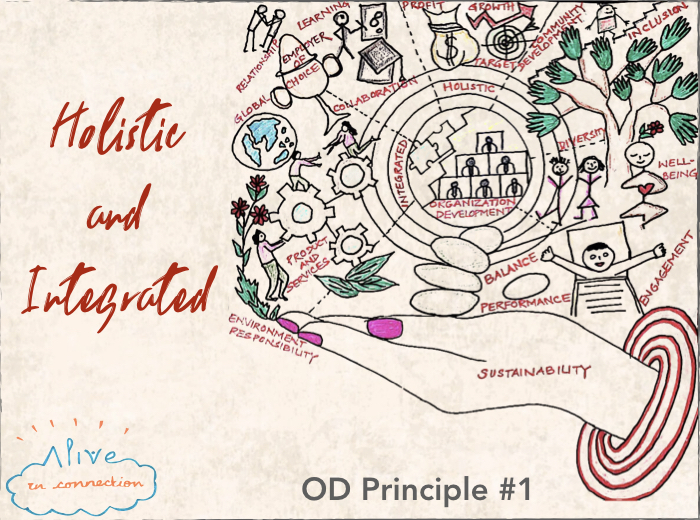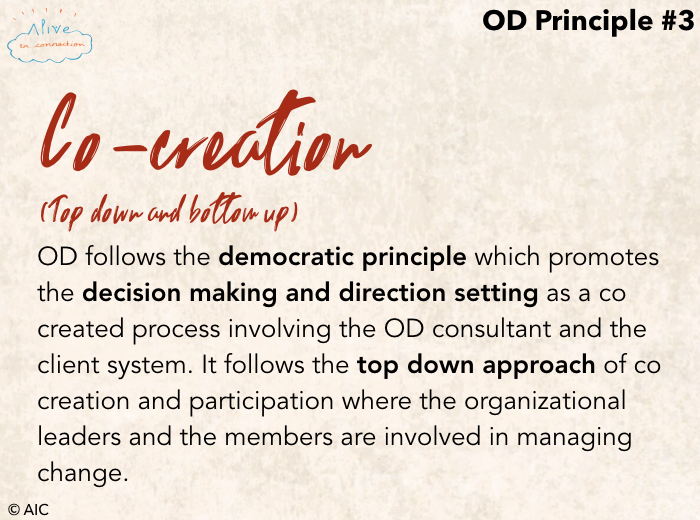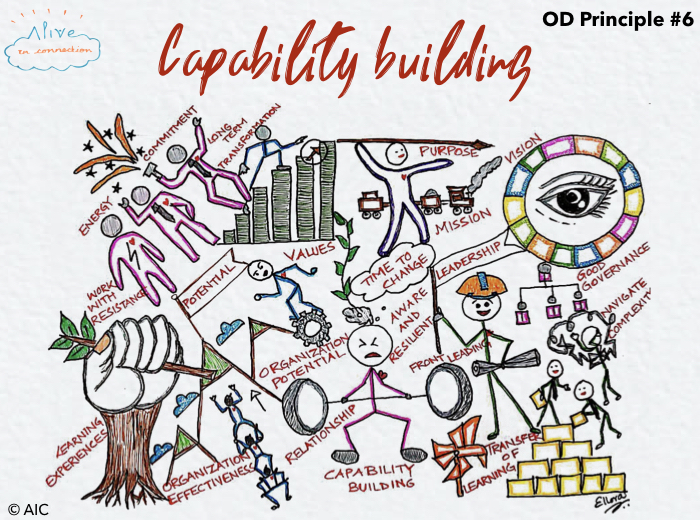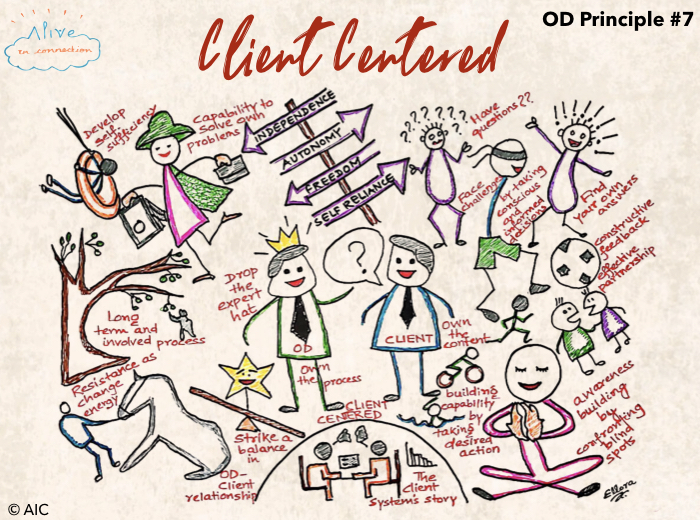Co-authored by Adi Raheja

Organization Development Principle 1: Holistic and Integrated
Organization Development (OD), the field is the most relevant in current times especially when the whole world is talking about interconnected and sustainable development.
Consider this case: One of the reputed chemical organisations hired a consultant to double its sales in 3 years. The consultant did a great work of building the team capability, improving the process and sales tracking. The team responded well and started bringing in more orders. But this situation brought consequential issues. The manufacturing wasn’t ready to scale its capacity. The vendors weren’t ready for the surge in demand. There were delays in meeting customer commitments and it eroded the brand value. The manufacturing department leaders reacted by increasing the workload and compromising the environment standards. The decrease in employee morale resulted in manpower issues and the neighbourhood got impacted by the environment hazard due to the improper waste disposal. What might have turned this aspiration into a catastrophe?


Organisation Development Principle 2 – Humanistic
Our experiences in a dynamic environment frame our emotions and thoughts. As humans we keep fulfilling our internal unmet needs through our actions in the quest of attaining full potential.
A top leader of a legacy corporation once mentioned in a meeting “People won’t do anything unless they are told to do. They do not take initiatives. Hence I use a strong stick and carrot approach, this is the only way work gets done.”
Belief- People need to be driven so I drive them. I drive them so they don’t drive themselves.
This org was struggling to catch up with the young competitors and losing out on market share.


Organisation Development Principle 3 – Co-creation
Have you wondered why majority of change projects fail? Challenge lies in implementation & Institutionalization of a change. If people don’t have the buy in and question the worthiness, the change hasn’t been able to win their hearts to win their commitment. Winning hearts require involvement, active engagement and ownership.
A tech giant org 6 years ago got a new CEO who decided to bring a change by listening to the employees. They launched 40 apps in 60 days for employees. Over 6 months, the employee app usage went down. It was revealed through a survey that while all this was created for employees, they never wanted it. They didn’t feel they were a part of the change. Is there a difference between creating for people and co-creating with people?
Co-creation stands at the core of a learning organization and enables a change process. In a dynamic and uncertain world, facts keep changing and new truths evolve. New meaning of things has to be constructed with all the stakeholders with varied expertise, experience and energy so that everyone can contribute and take care of each other’s needs.


Organisation Development Principle 4 – Collaborative learning
Continuous improvement initiatives are being rolled out all over but the success rate remains dubious. The basic truth around is that continuous improvement requires a commitment to learning and the most effective learning comes from collaborative learning.
Consider this case-
A start-up saw tremendous growth in its early years. They key to their success was the culture of learning and collaboration. People learned from each about technology, processes and clients. This gave them a level of agility that is rarely available to a large organization which also became their competitive advantage.
After 5 years of double digit growth, the start-up hired a consultant to develop a PMS in their 150 people organization. The new PMS induced internal competition. People shared less with each other and focused more on their personal growth and performance. The new PMS took away the collaborative learning spirit of the organization. An example of a developmental initiative that went anti-development.


Organisation Development Principle 5 – Collective wisdom
With time humans internalize the wisdom which comes naturally in the process of transcending the obstacles and understanding the complexity of life. Imagine if organizations could harness the collective wisdom of groups giving rise to wise perspectives, plans and actions.
After hiring two Big-5 consulting firms & spending millions of dollars to improve the traditional ways of working, a legacy Indian giant was stuck in the same problem of internal bureaucracy leading to delay in customer deliverables. The consultants thought that they had a solution to the clients problem – a situation that was created internally over decades.
An OD consultant who was approached humbly admitted “I don’t have a solution but we can together find one”. A Large Scale Interactive process was facilitated with 300 employees across levels under one roof -from operators to MD. They together came up with one simple solution of no internal emails for the first two hours of the day.
A simple initiative that encouraged them to talk to each other and get things done faster than emails!


Organisation Development Principle 6 – Capability building
Organization, like a living being, passes through the different terrains of its life in the form of various obstacles. The collective skills & ability building of an organization is very much like the muscle building of a body, which marks its readiness to fight the volatility, complexity, uncertainty & ambiguity of the external world. The capability building principle of OD prepares the organization to function at its optimum potential.
The growth curve of a growing organization had flattened. They hired an internal OD consultant who implemented some very effective change initiatives. The organization picked up & were able to fulfil the goals they were aspiring for.
Couple of years later the consultant changed his job. The organization again hit the plateau. The employees fondly remembered this consultant on how he helped in the turnaround.
The question is did the consultant truly do any good to the org? He may have helped the org grow but not develop. True development happens with involvement in the process & transfer of learning. The consultant like a magician took away his secrets.


Organisation Development Principle 7 – Client- centered
The human systems are capable of self-initiated change & development when provided with appropriate processes & supportive conditions. The role of the OD practitioner is to drop being an ‘expert’ on the content (what to do) and take the client through a process (how to do) which may require confronting the client system for building awareness.
A consultant who was consulting a service org used to penalize the participants when they arrived late at the Values workshop. Being punctual was one of the personal values of the consultant & she felt offended if she had to wait for the late comers. She ensured the inclusion of punctuality as one of the client’s values & ensured that the same was linked to rewards. The culture of the org thrived on adding a little extra into every client experience & warmly apologizing for being late in the next meeting. With punctuality as one of their new values, the service org started having hurried conversations with the client. The focus on task replaced the focus on relationship. The personal value of punctuality of the consultant did not do any good to the client.


Organisation Development Principle 8 – Systemic, planned and ongoing process
A 300-people engineering company gathered it’s 20 ‘key leaders’ chosen by the CEO for a strategic offsite every year. There they discussed major strategic changes and initiatives. The leaders were then expected to communicate and implement the strategic changes across the organisation. Year after year, they experienced that the commitment towards the change efforts fizzled out within 2-3 months of the offsite. The leaders shied away from talking about it during their quarterly meetings. The next offsite with the key leaders would begin with “what went wrong?” and yet, produce the same results. Sounds familiar?
OD is not a one-time or once-in-a-year activity. It is not for the important few. It isn’t about making major changes either.
Transformation and growth require small, consistent, systemic change efforts to be institutionalised in the bigger system. OD’s Action Research philosophy is about learning from the uncertainties and complexities of a dynamic environment and continuously implementing those learnings.


Organisation Development Principle 9 – Value based ethical practice
Values are the foundation of OD practice as they determine the degree to which OD practitioners are aligned with the purpose and values of client organizations and how they work with clients. OD practitioner’s values shape individual purpose and meaning, personal conduct, and means of working with clients. Values can come into conflict giving rise to ethical dilemmas.
Consider a couple of cases:
1. An OD practitioner was pushed by the CEO to share the findings and other such data of a survey in person before presenting it to the leadership team. The CEO wanted to be sure of any communication that goes to the leadership team and wanted to “tweak” it as per his understanding of what is right for him.
What would be the most ethical thing to do? What is at stake for both, the OD practitioner and the
CEO?
2. As OD practitioner, some information has been received from that system that would help the primary client, but if it is used, the promises of confidentiality given to the others in the client system gets violated. What should be the response and how can values guide the action?


Organisation Development Principle 10- ‘Self’ as an instrument of change
Use of ‘self’ in OD is essential to make & give a ‘presence’ to the client system which is otherwise missing. Presence is use of self with intent, a part of the personal style of the OD practitioner which is much needed for a holistic & deliberate engagement with the client system. It is only through awareness of internal experiences & paying attention to the reaction and response of others, the OD practitioner can expand on the presence to be an effective change agent & have an impact on the system. Self-awareness minimizes the fixed patterns that might get in the way of effectiveness.
Consider the case:
An OD practitioner being hired becomes a helper in the process to the client system. This helper role is an important vehicle to deliver genuine services as well as to satisfy own needs of ‘ being significant’ & ‘worthy’ or as an object to be valued and appreciated by clients. While these motivations are a part of we humans but a lack of awareness may take us overboard with unrealistic and unnecessary help which doesn’t do any good to the system but makes it look that they are not up to the mark.

Organisation Development Principle 11 – Congruence between Saying and Doing
This is the 11th and the final one in our series of Organisation Development Principles.
Couple of years ago, I was interviewing a CEO as a part of a diagnostic to develop his first line leaders. I inquired about what would be one key change that he would like to see in his leadership team members? And the CEO said, “My team is not solution oriented. They don’t take decisions to resolve issues. They just come to me with problems. At the end of the intervention, I want them to come to me with three solutions along with every problem they bring. And then I’ll tell them which one to go for.”
Can you see the paradox here? Do you think that the CEO was congruent in his saying and doing? What would really happen if a consultant designed an intervention to meet this objective?

This is our original work including the art work and the case studies. Thank you for reading, supporting and sharing it in your network. You can download this document for your future reference.
